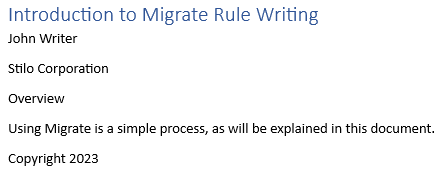Syntax #
p.prolog
Purpose #
The p.prolog annotation is used to tag an element as containing prolog metadata for the topic. This information is typically not shown when the content is rendered. The prolog element acts as a container for content, rather than being content itself.
This annotation has different output depending on the context in which it is used. If this annotation is applied to the first content in a topic, it will be tagged as an <author> element. If the annotation is applied to content following other prolog content, it will be tagged as a <data> element. If this annotation is applied to content not directly following other prolog content, it will be tagged as a new <prolog> element wherever in the topic it appears.
Applying this annotation sequentially will create a series of prologs inside a single other element, such as a <p> or <prereq> element.
This annotation will cause any following prolog content (e.g. data or metadata) following it to be merged inside the prolog element.
Examples #
The following is an example of a time when you might want to use the annotation:

The following is an example of a time where you might want to use the annotation:

The following is the DITA XML output for the rule:
<title>Introduction to Migrate Rule Writing</title>
<prolog>
<author>John Writer</author>
<publisher>Stilo Corporation</publisher>
<metadata>
<category>Overview</category>
</metadata>
<data>Using Migrate is a simple process, as will be explained in this document.<data>Copyright 2023</data></data>
</prolog>



